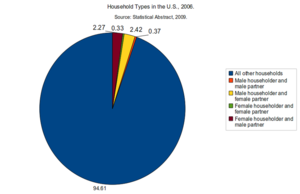Cohabitation
Trends And Patterns, Reasons For Cohabitation, Meanings Of Cohabitation, Consequences Of Cohabitation, Conclusion

Cohabitation, sometimes called consensual union or de facto marriage, refers to unmarried heterosexual couples living together in an intimate relationship. Cohabitation as such is not a new phenomenon. It has, however, developed into a novel family form in contrast with conventional marriage. Part of this change is associated with the absolute rise in cohabitational relationships. Since the 1970s, many countries, particularly those in North America and Europe, have experienced rapid growth in their cohabitation rates. Although these numbers generally remain small relative to families composed of married couples, the absolute numbers of cohabiting couples have increased dramatically. Cohabitation was obscure and even taboo throughout the nineteenth century and until the 1970s. Nonmarital unions have become common because the meaning of the family has been altered by individualistic social values that have progressively matured since the late 1940s. As postwar trends illustrate, marriage is no longer the sanctified, permanent institution it once was. The proliferation of divorce, remarriage, stepfamilies, and single parenthood has transformed the institution of the family. With these structural changes, attitudes toward nonmarital unions have become increasingly permissive.
Because cohabitation involves a shared household between intimate partners, it has characteristics in common with marriage. Similarities include pooled economic resources, a gender division of labor in the household, and sexual exclusivity. However, even though the day-to-day interaction between cohabiting couples parallels that of married couples in several ways, important distinctions remain. While some argue that cohabitation has become a variant of marriage, the available evidence does not support this position. Kingsley Davis (1985) points out that if cohabitation were simply a variant of marriage then its increased prevalence vis-à-vis marriage would lack significance. Sociologists treat cohabitation as a distinct occurrence not just because it has displaced marriage, but also because it represents a structural change in family relationships.
Cohabitational relationships are distinct from marital ones in several crucial ways. Although these differences have become less pronounced with the increase in cohabitation (and could thus eventually vanish), the following characteristics define the essential boundaries between cohabitation and marriage.
- Age. People in cohabitational relationships tend to be younger than people in marital relationships. This supports the argument that cohabitation is often an antecedent to marriage. The majority of cohabitational relationships dissolve because the couples involved get married;
- Fertility. Children are less likely to be born into cohabitational relationships than they are into marital relationships;
- Stability. Cohabitational relationships are short-lived compared to marital relationships. In Canada, only about 12 percent of cohabitations are expected to last ten years. By comparison, 90 percent of first marriages are expected to last this long (Wu 2000). The majority of cohabitational relationships terminate within three years. Although many of these relationships end because of marriage, the lack of longevity in cohabitations as such illustrates that these relationships have yet to develop into a normative variant of marriage;
- Social acceptance. Even with its numerical growth and spread throughout society, cohabitation is not as socially acceptable as marriage. Cohabitation is socially tolerated in part because it is expected that cohabiting partners will eventually become married. Indeed, according to U.S. data, about three-quarters of never married cohabitors had definite plans for marriage or believed they would eventually marry their partner (Bumpass, Sweet, and Cherlin 1991). The youthful profile of cohabitation shows that marriage is still the preferred choice of union for most couples. If cohabitation were a variant of marriage, it would have a larger prevalence in older cohorts. Although many people have chosen to delay marriage, most have not rejected it completely. A major reason cohabitations have lower fertility than marriage is because couples tend to abandon cohabitation when children are in the immediate future (Manning and Smock 1995). In most countries, marriage is perceived as the most secure and legitimate union when children are involved;
- State recognition. Unlike marriage, cohabitation is not sanctioned by the state, and persons in nonmarital unions do not necessarily acquire specific legal rights and obligations through their union. Without a formal ceremony and legal documentation, a couple is not married even if they have lived together for many years. However, after a set period of time (usually one or two years), cohabiting couples are recognized as common-law partners in some countries. In such instances, common-law partners can have similar rights and obligations as they would in a legal marriage. Common-law marriage can parallel legal marriage in terms of child support and custody, spousal maintenance, income tax, unemployment insurance, medical and dental benefits, and pensions. The degree to which cohabitors are treated like legally married couples usually corresponds to the degree nonmarital unions are socially accepted. But even where cohabitors do have rights, these are often unknown to cohabitors and more complicated to exercise than they are for married persons. In many cases, the rights that cohabiting couples possess have been established by court decisions rather than by state law, as they are for married couples. Perhaps the most crucial legal distinction between these unions is the absence of shared property rights in common-law relationships. Married couples acquire shared property rights upon establishing their union, but cohabiting couples must do so through the courts. In sum, no uniform and guaranteed set of rights applies to cohabitation. This deficiency shows that in most countries, cohabitation is not yet perceived as a legitimate variant to marriage from the perspective of the state.
Additional topics
- Homeless Families - Prevalence Of Family Homelessness, Causes Of Family Homelessness, Adaptations To Homelessness, Contrasting The Poor-but-housed With Homeless Families
- Later Life Families - Defining Later Life Families, Characteristics Of Later Life Families, Couple Relationships In Later Life, Retirement And Couple Relationships - Conclusion
- Cohabitation - Trends And Patterns
- Cohabitation - Reasons For Cohabitation
- Cohabitation - Meanings Of Cohabitation
- Cohabitation - Consequences Of Cohabitation
- Cohabitation - Conclusion
- Other Free Encyclopedias
Marriage and Family EncyclopediaFamily Theory & Types of Families